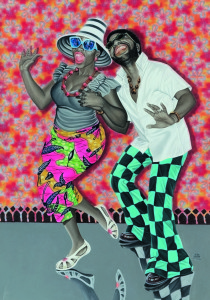ART-TRIBUTE:Beauté Congo 1926-2015 Congo Kitoko
The exhibition “Beauté Congo– 1926-2015 –Congo Kitoko”, is the biggest tribute to the artists from the Democratic Republic of Congo, presented at the Fondation Cartier pour l’art contemporain, in Paris, an overview of almost a century of the cultural life of the country, starting from the ‘20s till today.
By Efi Michalarou
Photo: Fondation Cartier pour l’art contemporain Archive
The exhibition incorporates 350 works from 41 artists. Most of these works have never been displayed, they were parts of private collections in Belgium, France and Switzerland, while others were dug out from colonial archives in Brussels and a few brought over from Kinshasa, direct from the artists themselves. This ambitious exhibition traces almost a century of the country’s artistic production, focusing on painting, it also includes music, sculpture, photography, and comic books, providing the viewers with the unique opportunity to discover the diverse and vibrant art scene of the country. The exhibition presents the works in a reverse chronological order, starting with the works of the contemporary young artists, who live and work in Kinshasa the capital of the country and ends with a series of “precursor” paintings, mostly watercolor, dating back to 1926 that had been found forgotten in the depths of the Library of Brussels archive by the curator. In 2003, Kura Shomali, Pathy Tshindele and Mega Mingiedi Tunga refused the narrow confines of the Académie des beaux-arts of Kinshasa and created the artists’ collective Eza Possibles, whose projects engage directly with the urban environment and with the citizens of Kinshasa. Sammy Baloji uses photomontage to relate colonial history to the recent history of the Congo. Ηe associates documentary photographs of a Belgian scientific expedition to Katanga (1898-1900) with watercolors of the painter Pierre Dardenne (1865-1900). In the 1970s, a group of young artists emerged in Kinshasa, defining themselves as “Popular Painters”. Most of them had worked as sign painters, and some had made comics before opening their studios in Kinshasa, exhibiting their paintings on walls of their buildings to attract passersby. Instead of imitating the European painting styles, the “popular painters” draw their inspiration from daily life in Kinshasa and explore politics, society and world events. The first generation which includes Moke, Pierre Bodo, Chéri Chérin and Chéri Samba, was revealed to the public in the exhibition “Art Partout”, presented at the Académie des Beaux-Arts de Kinshasa in 1978. Here they encountered great success. Beginning in the 1980s and continuing through to the present, innovative sculptors like Bodys Isek Kingelez and Rigobert Nimi have created intricate architectural models of utopian cities or robotized factories to explore the question of social cohesion. For them, art provokes self-renewal that in turn contributes towards a better collective future. In 1946, the French painter Pierre Romain-Desfossés founded the “Atelier du Hangar.” Instead of asking the artists to imitate European styles of painting, he encouraged them to freely exercise their imaginations and draw inspiration from their own traditions and the world around them. After the death of Pierre Romain-Desfossées in 1954, the “Atelier du Hangar” was integrated into the “Académie des Beaux Arts of Elisabethville”. Several talented artists were trained there including Mode Muntu and Jean-Bosco Kamba, who was one of the first painters to graduate from the Academy in 1958. In 1926, the Belgian administrator Georges Thiry discovered in the village of Bukama, in Katanga a group of painted huts. Enchanted by these paintings, he met the ivory carver Albert Lubaki and his wife Antoinette. In an effort to preserve this ephemeral art form which he so admired, he decided to provide them with paper and watercolors so that they may reproduce their paintings using materials that would better resist time. In the province of Western Kasai, where he met another hut painter, the tailor Djilatendo, and also provided him with painting materials, thus repeating the experience he began with Lubaki. With the support of Gaston-Denys Périer, who was government official and art lover stationed in Brussels, Georges Thiry endeavored to promote this painting which they found remarkably modern in style. The watercolors of Lubaki couple were exhibited between 1929-31, at the Palais des Beaux-Arts de Bruxelles, the Musée Ethnographique in Geneva and in Charles-Auguste Girard Gallery in Paris. In 1931 an exhibition of Djilatendo’s works was organized at the Galerie duCentaure in Brussels, where they were presented with those of the famous Belgian painters René Magritte and Paul Delvaux. Following a series of disagreements between Gaston-Denys Perier and Georges Thiry, Lubaki and Djilatendo were no longer provided with painting supplies. After a final exhibition of Lubaki’s work at the Musée Ethnographique in Geneva in 1941, we lose their trace.
Info: Beauté Congo -1926-2015 – Congo Kitoko, Curator: André Magnin, Fondation Cartier pour l’art contemporain, 261 Boulevard Raspail, Paris, Duration: 11/7-15/11/15, Days & Hours: Wed-Sun: 11:00-20:00, Tue: 11:00-22:00, http://fondation.cartier.com













